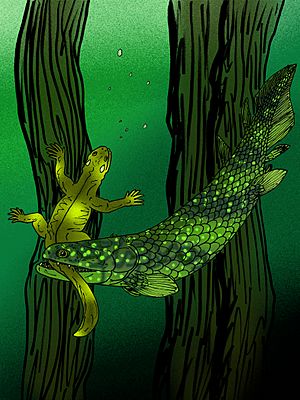Barameda facts for kids
Quick facts for kids Barameda |
|
|---|---|
 |
|
| B. decipiens | |
| Scientific classification | |
| Kingdom: | |
| Phylum: | |
| Class: | |
| Order: |
Rhizodontida
|
| Family: |
Rhizodontidae
|
| Genus: |
Barameda
|
| Species | |
|
|
Barameda was a type of ancient lobe-finned fish that lived a very long time ago. Its name means "fish trap" in an Indigenous Australian language. These fish swam in the waters of Australia during the Carboniferous period, about 355 million years ago.
Many ancient lobe-finned fish are known for their thick, fleshy fins. But Barameda was special because of its huge, rooted fangs. These fangs could be up to 22 centimeters (about 8.7 inches) long! The group of fish it belonged to, called Rhizodontida, got their name from these impressive teeth.
The biggest Barameda species, Barameda decipiens, could grow over 6 meters (20 feet) long. That's as long as a school bus! Barameda was a fierce carnivore. It hunted other fish, freshwater bugs, and maybe even some of the first animals to walk on land, called tetrapods.
Contents
What Did Barameda Look Like?
Barameda had a long, thick body, much like other large fish from the Carboniferous period. This shape helped it swim very powerfully. It could easily overpower its prey.
Its Body and Fins
Its body was covered in strong, bony scales. These scales were called cosmoid scales. Its head and gill covers (called operculum) were protected by thick bony plates. The bones in its skull were tightly joined together.
Barameda had very noticeable, sharp fangs. These fangs were smooth, without any jagged edges. It also had a special sense organ called a lateral line system. This system helped it detect movements and vibrations in the water. It was especially strong near its front fins.
Its front fins (pectoral fins) were larger than its back fins (pelvic fins). The scales on its fins overlapped a lot, making the pectoral fins like big paddles. Its anal fins and second back fin (dorsal fin) worked together to help it move its tail.
How Barameda Hunted
Barameda was an ambush predator. This means it would hide and then suddenly attack other fish. It might have also hunted early tetrapods, but we don't have direct proof of that.
Its Hunting Style
It probably used a "grab and drag" method. Its big fangs, located at the front of its mouth, were perfect for grabbing slippery prey. Once it had a grip, it would either thrash the prey at the water's surface or drag it underwater to hold it down.
This hunting style is similar to how some modern lobe-finned fish hunt. It's useful for catching animals that breathe air or are very fast and slippery. When Barameda bit down, its lower jaws would rotate inward. This helped to secure any prey it caught, making it harder for them to escape. This mechanism likely helped Barameda control struggling prey.
Who Were Barameda's Enemies?
Barameda was at the top of its food chain. It hunted many different animals. It didn't have many predators itself, except for its even larger relative, Rhizodus.
Other Ancient Predators
Tropical sharks during the Carboniferous period were generally smaller than these big lobe-finned fish. So, healthy adult Barameda probably didn't have much to fear from them. Some very large ancient sharks, like Parahelicoprion, could grow up to 6.4 meters (21 feet) long. However, these giant sharks lived in the open ocean or deep sea. This meant they didn't usually cross paths with the large Rhizodontidae fish like Barameda, which lived in freshwater.

